#JIM STARLIN
Text

Silver Surfer by Jim Starlin
1K notes
·
View notes
Text
Tim Drake is so funny to me as an Icon because Starlin wanted to kill the idea of child sidekicks,of Robin as a light. He wanted to kill the hope and joy of him. Wanted to slaughter the importance and responsibility of having someone relying on you,of having a child to come home to. And he was allowed to kill Jason,was allowed to kill Robin and then not even a year later Wolfman went "Here's a Robin so in love with the idea and responsibility of Robin that Dick Grayson imprinted himself on his brain and Tim hasn't stopped thinking about it since." And he became the Robin that can't stop being Robin and LMAO fuck you Jim Starlin,I'm glad you're here to see it.
#dc#dc batman#batman#jason todd#tim drake#bruce wayne#dick grayson#comics#a lonely place of dying#death in the family#jim starlin#marv wolfman#robin jason todd#dc robin#batman and robin#dc comics#comic books#robin tim drake#robin
648 notes
·
View notes
Text
I don’t think any comparison between Robins is going to be completely accurate unless you take into account the context surrounding characters, because it has made a huge difference in what opportunities the characters are given creatively and how they’re perceived.
Jason Todd got writers who hated him and hated the very concept of Robin. Tim Drake got writers who loved him and appreciated the role of Robin in Batman stories. Even without considering all the other factors (like Tim’s far more ideal timing in regards to continuity reboots), this is hugely impactful as to why Tim is traditionally considered a better Robin than Jason.
I mean this very literally: It’s hard to be a good Robin when even your writer wants you to be a bad one so he can kill you.
In regards to Damian, it is also a not insignificant factor that he was the first Robin introduced as a multiracial character. And DC had gotten a secure handle on the Robin legacy by that point, so they took more risks with Damian’s character than they did with Tim’s (who was very much meant to be the safe, ideal Robin after the mess with Jason). Damian also got writers who were disadvantageous to him. Damian’s more hostile introduction is wrapped up in all those factors. Edit: folks had great additions to the Damian situation as well.
Not that you can’t get anything interesting out of just comparing the Robins by parts of their characterization or backstories, but there’s a lot of things that go into the differences between the Robins and why people compare them the way they do.
#jason todd#tim drake#damian wayne#batfam#batfamily#dc#robin ii#robin iii#robin v#heroesriseandfall#jim starlin#robin mantle
2K notes
·
View notes
Text
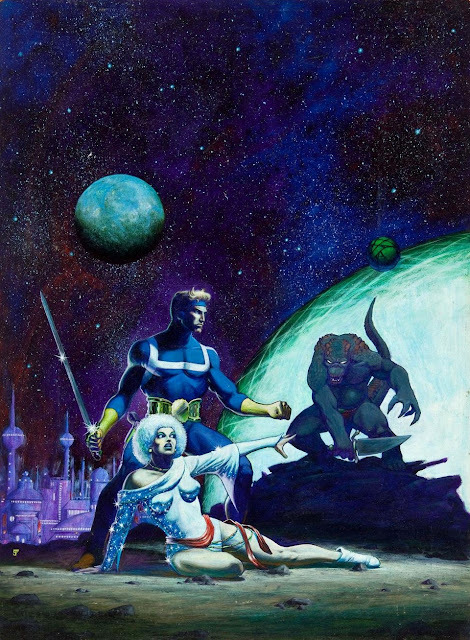
Starlord by Jim Starlin
171 notes
·
View notes
Text

Batman #423 (1988) by Jim Starlin & Dave Cockrum
250 notes
·
View notes
Text
No Birds Allowed: Batman without Robin
The usual claim is that Jason Todd was singularly hated by audiences. Dick Grayson, Carrie Kelley, and Tim Drake are proper, beloved Robins—and Jason Todd is the one and only outlier so unlikable that audiences killed him off by popular vote.
But this claim ignores a massive piece of the puzzle—the Robin role has long been treated as an outdated remnant of a childish era, not only by a significant share of Batman fans, but also by Batman creative teams. While there were definitely fans who hated Jason Todd, he was at least partly chosen to be killed as a scapegoat for some long-standing complaints about the Robin role in Batman stories.
The 1988 poll to kill Jason Todd wasn't just a poll to kill Jason Todd—the poll to kill Robin was a poll to kill Robin.
Fan letters columns from Batman #221 and Detective Comics #398, reacting to Dick leaving for Hudson University in Batman #217 (1969):
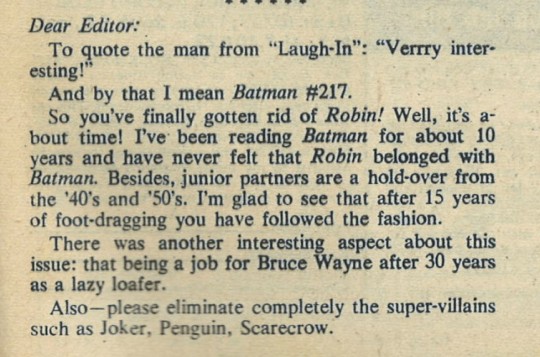
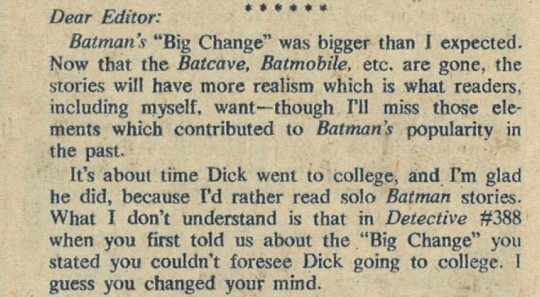
Denny O'Neil Batman/Detective Comics writer (1970-1980) Batman group editor (1986-2000) on sending Robin away to Hudson University:
Dan Greenfield: Actually, last night I went back through my comics and the one thing that always strikes me is that before you came onto the character, they’d already made the decision to have Robin leave. Robin was up at Hudson University and was used sparingly from that point forward.
Denny O’Neil: Well, that was a conscious decision of mine.
Greenfield: Oh!
O’Neil: Yeah, I mean … I had been offered Batman a year before I did it.
Greenfield: No kidding? I wanna hear this.
O’Neil: Because that was in the (Batman TV show) camp thing.
The comics were very half-heartedly following in the footsteps of the camp because it was having a palpable effect on circulation. That’s not always true but it was in that case.
Camp as in the sense — as opposed to the more erudite sense — this one-line joke about: “I loved this stuff when I was 6 and now that I’m 28 and I have a bi-weekly appointment with a therapist and a little, mild drug habit and two divorces, ‘Look how silly it is.'”
I would go into the most literary bar in Greenwich Village on (Wednesday) or Thursday evenings and there would be writers and poets and college professors, all looking at Batman! But when that was over, it was over. It was like somebody turned a switch.
And that’s when (editor) Julie (Schwartz) said, in his avuncular way, did I have any ideas for Batman? And at that point, I wasn’t going to be asked to do camp. I was going to be asked to do anything within the bounds of good taste, etc., that I wanted to.
O'Neil, quoted from “Notes from the Batcave: An Interview with Dennis O’Neil” in The Many Lives of The Batman: Critical Approaches to a Superhero and His Media:
There was a time right before I took over as Batman editor when he seemed to be much closer to a family man, much closer to a nice guy. He seemed to have a love life and he seemed to be very paternal towards Robin. My version is a lot nastier than that. He has a lot more edge to him.
O'Neil in 2015:
Modern Batman does not do camp. He has to evolve but to stay true to the concept he has to stay lonely. The kids, there shouldn't be many. Keep him the lone, obsessed crusader and the stories will be better. We did a story called Son of the Demon. It told a story where he had a kid, a baby. It wasn't in continuity. These days, the kid came back and became the new Robin, and I hear that Batman's got a few more running around.
Jim Starlin, Batman writer (1987-1988), writer of A Death in the Family:
I tried to avoid using [Robin] as much as I could. In most of my early Batman stories, he doesn’t appear. Eventually Denny asked me to do a specific Robin story, which I did, and I guess it went over fairly well from what I understand. But I wasn’t crazy about Robin.
I thought that going out and fighting crime in a grey and black outfit while you send out a kid in primary colors was kind of like child abuse. So when I started working on Batman, I was always leaving Robin out of the stories, and Denny O’Neil who is the editor finally said, "You gotta put [Robin] in."
youtube
In the one Batman issue I wrote with Robin featured, I had him do something underhanded, as I recall. Denny had told me that the character was very unpopular with fans, so I decided to play on that dislike.
[...] At that time, DC had this idea that they were gonna do an AIDS education book, and so they put a box out and wanted everybody to put in suggestions of who should contract AIDS and perish in the comics. I stuffed it with Robin. They realized it was all my handwriting so they ended up throwing all my things out. About six months later, Denny came up with this idea of the call-in thing.
[...] I didn’t find out about it until I came back [from Mexico] and found out that, just as I expected, my ghoulish little fans voted him dead. But by a much smaller margin than I’d imagined. It was only like 72 votes out of 10,000, so statistically it was next to nothing.
Dan Raspler, assistant editor/associate editor to Denny O’Neil (1988-1990):
Denny wasn’t really interested in comics continuity, and he didn’t like superheroes. And if you read his work, you see his influence was really a pushing away from the conventions at the time—it was growing old, that sort of Golden Age-y, Silver Age-y stuff, and Denny sort of modernized it, and he never stopped feeling that way. Jim Starlin’s Batman appealed to Denny. It was a little more ‘down to Earth.
Nobody liked Robin at the time. For a while Robin was not—it didn’t make sense in comics. Comics were darkening, and so having the kid was just, it was silly, and even at the time I kind of didn’t. Now Robin is my favorite all-time character, but at the time when I was twenty-whatever, I accepted kicking Robin out, the short pants and all the rest of it.
Comic shop owner Phil Beracha on A Death in the Family, quoted in The Sun Sentinel (October 22, 1988):
"I got 100 copies, and I don't expect them to last past the weekend," said Phil Beracha, owner of Phil's Comic Shoppe in Margate. "I usually get 50 copies of Batman. I doubled my order, and I still expect to sell out."
The readers voted right, Beracha said. "Robin is an outdated concept. He was created in the `40s, and back then in a comic book you could have a kid beating up grown men. I don't think that works today."
Writer Steve Englehart, quoted in "Batman, the Gamble; Warner Bros. is betting big money that a 50-year-old comic book vigilante will be a `hero for our times'" in the Los Angeles Times (June 18, 1989):
Writer Steven Englehart, who did a series of Batman stories in Detective Comics, also worked up some movie treatments. In a letter to Comics Buyer's Guide, he revealed the approach he had in mind, which would have pleased Batfanatics: "My first treatment had Robin getting blown away in the first 90 seconds, so that every reviewer in the country would begin his review with, `This sure isn't the TV show.' "
Michael Uslan, producer and film rights holder for the 1989 Batman film:
I only let Tim [Burton] see the original year of the Bob Kane/Bill Finger run, up until the time that Robin was introduced. I showed him the Steve Englehart/Marshall Rogers and the Neal Adams/Denny O'Neil stories.
My biggest fear was that somehow Tim would get hold of the campiest Batman comics and then where would we be?
"Death Knell for the Campy Crusader" in the Orlando Sentinel (23 June 1989):
For most people, the name Batman summons up a picture of a clown in long johns, a Campy Crusader who - with the young punster Robin - ZAPed and POWed his way into our lives. That's the Batman that appeared on TV in the mid-'60s, and that's the Batman that the world at large knows.
Such is the power of television.
But this ludicrous image may become obsolete now that the new, $40 million Batman movie has opened. Robin is absent from the film, as are the perky Batgirl and the utterly superfluous Aunt Harriet of the TV series. And though the movie has plenty of sound effects, they don't appear on the screen as words, spelled out in neo-Brechtian absurdity.
Sam Hamm, writer for Batman (1989 live-action film):
The Case of the Disappearing Robin is high comedy. Tim (Burton) and I had worked out a plotline that did not include the Boy Wonder, whom we both regarded as an unnecessary intrusion. Really: Our hero was crazy to begin with. Did he have to prove it by enlisting a pimply adolescent to help him fight crime? Was Bat-Baby unavailable?
But the studio was insistent: There was no such thing as solo Batman, there was only Batman and Robin. So, after holding off the executives for as long as we could, Tim and I realized we had better try to accommodate them. He flew up to my house in San Francisco and we walked around in circles for two days, finally deciding that there was no way to shoehorn Robin into our story.
[...] We figured that if we managed to squeeze him in, the lame hacks who were making the sequel could worry about what to do with him next.
When the film went into production in London, and ran seriously over budget, WB started looking for a sequence that could be cut to save money. And there was one obvious candidate: Intro Robin!
So Robin was cut from the movie and shoved back to Batman Returns— from which he was cut yet again and shoved back to Batman Forever.
Grant Morrison on creating Arkham Asylum: A Serious House on Serious Earth (written 1987-1988, published 1989) with Dave McKean (see the annotated script's fourth page):
The original first draft of the script included Robin. Robin appeared in a few scenes at the beginning then remained at Police Headquarters for the bulk of the book, where he spent his time studying plans and histories of the house, in order to find a way in to help his mentor. Dave McKean, however, felt that he had already compromised his artistic integrity sufficiently by drawing Batman and refused point blank over for the Boy Wonder — so after one brave but ridiculous attempt to put him in a trench coat, I wisely removed him from the script.
Paul Dini on Batman: The Animated Series (1992), as told in the 1998 book Batman Animated:
The Fox Network, on the assumption that kids won't watch a kid’s show unless kids are in it, soon began insisting that Robin be prominently featured in every episode. When Fox changed the title from Batman: The Animated Series to The Adventures of Batman & Robin, they laid down the law-no story premise was to be considered unless it was either a Robin story or one in which the Boy Wonder played a key role. Out were underworld character studies like “It's Never Too Late"; in were traditional Batman and Robin escapades like “The Lion and the Unicorn.” A potentially intriguing Catwoman/Black Canary team-up was interrupted in midpitch to the network by their demand, “Where's Robin?” When the writers asked if they could omit Robin from just this one episode, Fox obliged by omitting the entire story.
Looking back, there was nothing drastically wrong with Robin's full-time insertion into the series—after all, kids do love him. Our major gripe at the time was that it started turning the series into the predictable Batman and Robin show people had initially expected it would be. For the first season, Batman had been an experiment we weren't sure would work. We were trying out different ways of telling all kinds of stories with Batman as our only constant. For better or worse, having a kid forced him, and the series, to settle down.
Christian Bale, star of Christopher Nolan's The Dark Knight trilogy (2008):
If Robin crops up in one of the new Batman films, I'll be chaining myself up somewhere and refusing to go to work.
Summed up
Among the keepers of Batman, there has been a vocal contingent arguing against the inclusion of Robin. They argue that Robin damages Batman's brooding, solitary persona. They argue that the concept of Robin is too ridiculous and fantastic for the grounded, gritty ideal of Batman. They argue that a respectable version of Batman shouldn't allow, encourage, or train "child soldiers" to endanger their lives fighting against violent evil-doers.
The original and most iconic Robin, Dick Grayson, has definitely benefited from his deep roots in DC lore and his consistent popularity among fans—and yet even he has been shunned from various Batman projects over the decades. When even he struggles to get his foot in the door, his successors face stiffer opposition.
So it's not quite correct to say that Jim Starlin hated Jason Todd. In his own words, Starlin wasn't fond of Robin, and his storytelling (most obviously A Death in the Family) set out to argue against Batman having any kind of "partner" at all. This, following the wildly successful comic that treated Barbara Gordon as a disposable prop. A growing audience welcomed the Dark Age, and the gruesome spectacles made of kid-friendly elements like Batgirl and Robin.
This trend could be broken by the upcoming sequel to The Batman and by the planned slate of upcoming DCU films. But most Robin fans will tell you that many movie-going Batman fans still have their doubts about Robin sharing Batman's spotlight.
#DC Robin#Dick Grayson#Jason Todd#DC Comics#Batman meta#Batman comics#Robin DC#Batkids#Batdad#Batfamily#thekillingvote#Jason Todd meta#Grant Morrison#Tim Burton#Dennis O'Neil#Jim Starlin#Batman 1989#Nolanverse#Christian Bale#Steve Englehart#Barbara Gordon#Jimmy Olsen#Burtonverse#Michael Uslan#Battinson#DC Batman#Bruce Wayne#Arkham Asylum: A Serious House on Serious Earth#described#ID in alt
215 notes
·
View notes
Text
Jim Starlin trying to make Robin!Jason unlikable by having him get angry about women getting assaulted and their perpetrators getting off scot free: Man this is such a genius idea that can not backfire on me in any way
#jim starlin#i know it was an 80s comic but like#its so funny how THOSE were his attempts at making jason “UnLiKaBLe”#lol#lmao even#jason todd#robin 2#robin jason
132 notes
·
View notes
Text

Thanos VS Warlock and Captain Mar-Vell. Painted art by Jim Starlin.
#comics#comicart#scifination#art#fiction#scifi#superheroes#marvel#vintagecomics#marvel comics#jim starlin
186 notes
·
View notes
Text
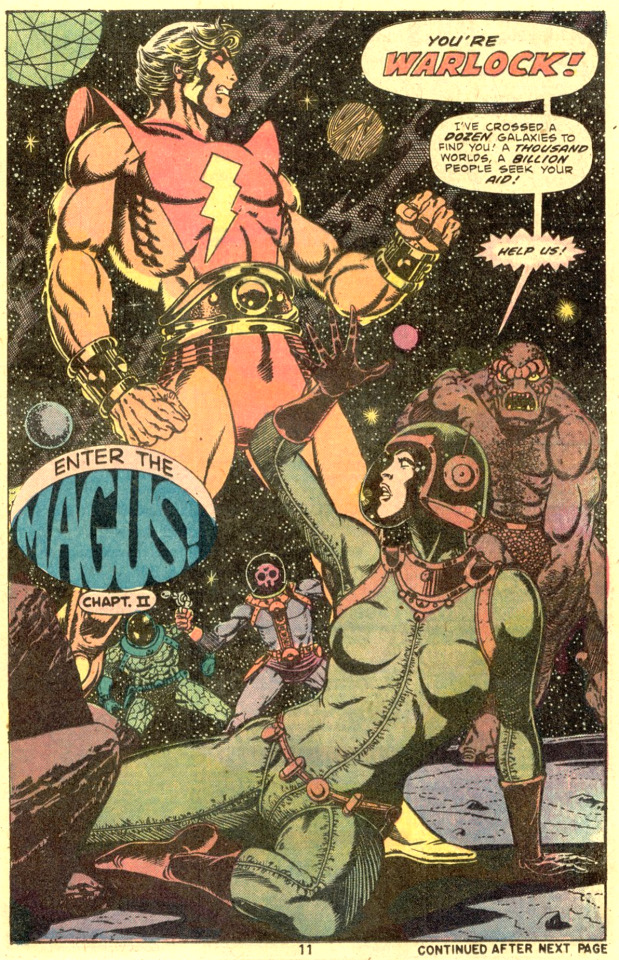
Adam Warlock in Strange Tales #178 by Jim Starlin
101 notes
·
View notes
Text

What a conceited ass…
#cosmic odyssey#starfire#princess koriand'r#conceited ass#huh#Jim Starlin#mike mignola#dc comics#comics#80s comics
207 notes
·
View notes
Text

Dreadstar
Art by Richard Pace
148 notes
·
View notes
Text

56 notes
·
View notes
Photo
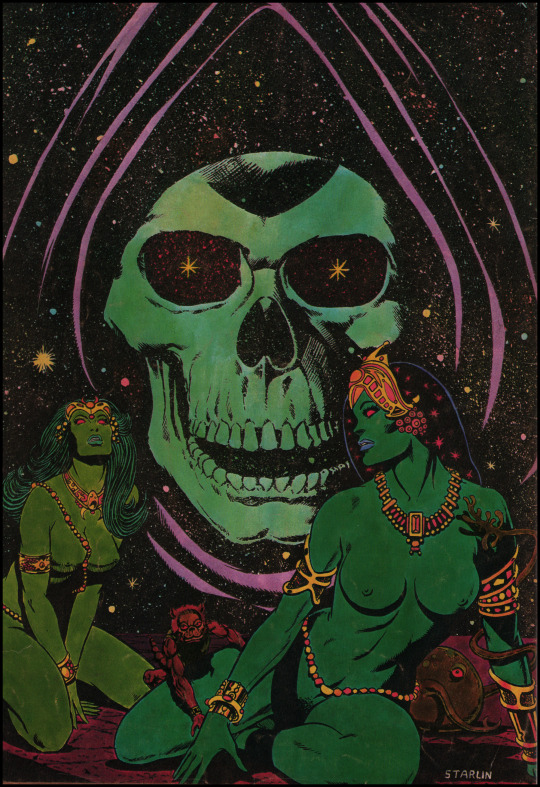
Star Reach #1, April 1974. Back cover art by Jim Starlin.
Greystoke Trading Company.
#star reach#star*reach#jim starlin#comic book art#fantasy#fantasy art#comic books#comic book covers#underground comics#independent comics#1970s
978 notes
·
View notes
Text
Darkwing Duck’s* Biggest Fans Haters
*As in the old tv show from the world of DuckTales (2017), not the superhero Drake Mallard assumes the identity of to fight evil
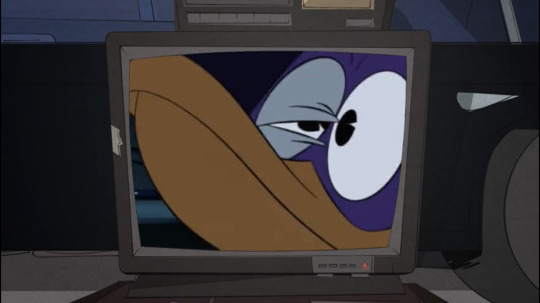
To fans like Drake Mallard and Launchpad McQuack, Darkwing Duck is the greatest piece of television history that helped shape their lives to become the ducks they are today thanks to its titular hero who never gave up despite the odds against him
To the rest of the world, Darkwing Duck was just another superhero show from the 90s that starred a problematic diva d-list actor that may or may not have died
Opinions are subjective of course, neither are 100% correct nor incorrect but I feel like when the fandom talks about Darkwing Duck it’s always about the characters that would also like the show. So why not flip the script a little? We’ll start small and work our way up to its biggest hater
Gosalyn Waddlemeyer:
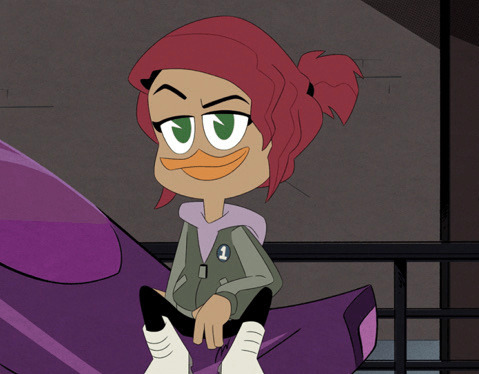
“GOSALYN!?” You might be screaming at your monitor/phone to which I have to say:
“Yeah”
Again we are not talking about the Drake Mallard or his super identity here, but the tv show he and Launchpad are obsessed with. Because frankly, I bet Gosalyn loves doing all that superhero stuff with her adoptive dads. It’s a cool life to live!
Other than the fact that Drake is a huge nerd who INSISTS that Gosalyn do her “homework” and watch every episode of Darkwing Duck, read all the sacred texts (comic books), and playing the original Darkwing Duck video game on the original hardware so she won’t use the rewind or save features that modern games or ROMs have
Like all kids who have had an adult push their interests onto them, she has a little disdain for the show. But not a whole lot since she’s first on this list. I like to think she’s in the same boat as Dewey where she finds the show cheesy and doesn’t really hate it per say and sees why Drake and LP love the show. She even has a few guilty pleasure episodes
But one thing she doesn’t understand is why Drake and Launchpad insist on watching the Darkwing Duck Christmas Special every year when they’re both practicing Jews
Scrooge McDuck:

Yeah the old man can barely remember Drake, let alone the Darkguy Drake played in that movie he cancelled so I don’t really see Scrooge being a fan of the Masked Mallard. (No, not that Masked Mallard OG DuckTales fans)
If Scrooge did sit down and watch the show, he’d find it to be rather ridiculous if anything. Some vigilante running around dressed like The Spirit or The Shadow or whatever superhero kids are into these days getting slapped around and fighting back just doesn’t seem like his cup of tea
I like to think when Donald and Della were kids they watched Darkwing Duck at the mansion and Scrooge just walked by the room, looked at the TV for a few seconds, scoffed, and moved on with his life forgetting all about that nonsense his niece and nephew were watching
Louie Duck:

Honestly I always had this headcanon that Louie just isn’t a fan of superheroes. Like at all. He finds the stories all copy and paste, using all the cliches he hates from other genres and putting them in tights.
And don’t even get him started on superhero related adventures! If he sees a sky beam, Louie is running in the opposite direction of it. He’s not dealing with the many different diva supervillains out there trying to take over the world with cartoony extreme measures, he doesn’t wanna be around all that property damage
He does have a favorite superhero tho. Waddle Duck because he gave him a Pep once
Lena Sabrewing:

She thinks it’s lame.
Gandra Dee:
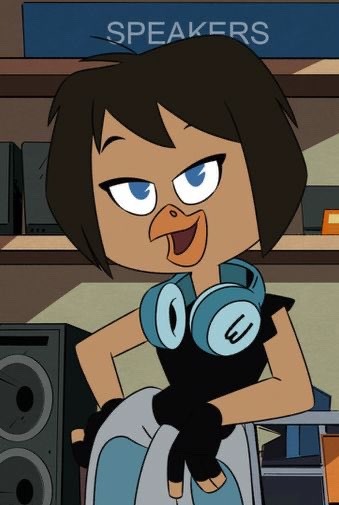
This is a no brainer for me. Gandra Dee made herself Darkwing Duck’s biggest hater the moment she heard the duck talk shit about Gizmoduck around Fenton who insisted she does not reveal his secret identity to Drake, because Drake is all he has left
Wanting to respect her boyfriend’s wishes, Gandra decides not to spill the beans but instead add more fuel to the fire by talking shit about Darkwing Duck
And she does not hold back
She’s not ashamed to talk shit on the show. It’s predictablity, it’s cheesiness, the plot holes, how lame it was for its own time, etc
It ain’t her childhood, she ain’t afraid to fight dirty either. She will bring up problematic episodes that depicted races in a not so good and stereotypical light (“It was the nineties! They were different times!” -Drake probably) such as the fact that in one episode Darkwing Duck called a group of Native Americans “primitive savages” or that a non-Asian actor played an Asian character in a sterotypcial manner and that how one of the characters names was “Duck Ling”(Okay but for real, all that shit did happen in the OG show.)
This of course frustrates Drake who is extra suspicious of Gandra ever since he saw her with Gizmoduck and writes her off as a blind fan girl who doesn’t know what she’s talking about
She’s pretty chill about not being into the show with Launchpad tho. He respects her opinions because he’s Launchpad and at the end of the day Gandra is still his friend
#ducktales headcanons#ducktales 2017#darkwing duck#jim starlin#launchpad mcquack#gosalyn waddlemeyer#gosalyn mallard#scrooge mcduck#louie duck#gandra dee#ducktales#DuckTales fandom#duckblr#lena sabrewing#lena ducktales
97 notes
·
View notes
Text

#batman: a death in the family#a death in the family#batman#jason todd#robin#jim starlin#marv wolfman#george perez#dc#dcu#dc comics#poll
77 notes
·
View notes
Text

Original Art - FOOM #09 Cover (1975) by Jim Starlin
#Comics#Marvel Comics#FOOM#Jim Starlin#Adam Warlock#Silver Surfer#Captain Marvel#Mar-Vell#Science Fiction#Vintage#Art#Marvel#Marvel Magazines#Magazines#Original Art#1975#1970s#70s
93 notes
·
View notes